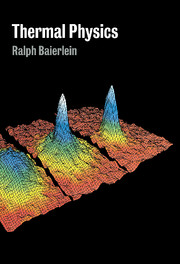Book contents
- Frontmatter
- Contents
- Preface
- 1 Background
- 2 The Second Law of Thermodynamics
- 3 Entropy and Efficiency
- 4 Entropy in Quantum Theory
- 5 The Canonical Probability Distribution
- 6 Photons and Phonons
- 7 The Chemical Potential
- 8 The Quantum Ideal Gas
- 9 Fermions and Bosons at Low Temperature
- 10 The Free Energies
- 11 Chemical Equilibrium
- 12 Phase Equilibrium
- 13 The Classical Limit
- 14 Approaching Zero
- 15 Transport Processes
- 16 Critical Phenomena
- Epilogue
- Appendix A Physical and Mathematical Data
- Appendix B Examples of Estimating Occupation Numbers
- Appendix C The Framework of Probability Theory
- Appendix D Qualitative Perspectives on the van der Waals Equation
- Index
2 - The Second Law of Thermodynamics
Published online by Cambridge University Press: 05 June 2012
- Frontmatter
- Contents
- Preface
- 1 Background
- 2 The Second Law of Thermodynamics
- 3 Entropy and Efficiency
- 4 Entropy in Quantum Theory
- 5 The Canonical Probability Distribution
- 6 Photons and Phonons
- 7 The Chemical Potential
- 8 The Quantum Ideal Gas
- 9 Fermions and Bosons at Low Temperature
- 10 The Free Energies
- 11 Chemical Equilibrium
- 12 Phase Equilibrium
- 13 The Classical Limit
- 14 Approaching Zero
- 15 Transport Processes
- 16 Critical Phenomena
- Epilogue
- Appendix A Physical and Mathematical Data
- Appendix B Examples of Estimating Occupation Numbers
- Appendix C The Framework of Probability Theory
- Appendix D Qualitative Perspectives on the van der Waals Equation
- Index
Summary
Chapter 2 examines the evolution in time of macroscopic physical systems. This study leads to the Second Law of Thermodynamics, the deepest principle in thermal physics. To describe the evolution quantitatively, the chapter introduces (and defines) the ideas of multiplicity and entropy. Their connection with temperature and energy input by heating provides the chapter's major practical equation.
Multiplicity
Simple things can pose subtle questions. A bouncing ball quickly and surely comes to rest. Why doesn't a ball at rest start to bounce? There is nothing in Newton's laws of motion that could prevent this; yet we have never seen it occur. Why? (If you are skeptical, recall that a person can jump off the floor. Similarly, a ball could—in principle—spontaneously rise from the ground, especially a ball that had just been dropped and had come to rest.)
Or let us look at a simple experiment, something that seems more “scientific.” Figure 2.1 shows the context. When the clamp is opened, the bromine diffuses almost instantly into the evacuated flask. The gas fills the two flasks about equally. The molecules seem never to rush back and all congregate in the first flask. You may say, “That's not surprising.” True, in the sense that our everyday experience tells us that the observed behavior is reasonable. But let's consider this “not surprising” phenomenon more deeply.
- Type
- Chapter
- Information
- Thermal Physics , pp. 24 - 50Publisher: Cambridge University PressPrint publication year: 1999



